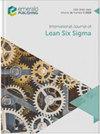Green lean six sigma sustainability – oriented project selection and implementation framework for manufacturing industry
IF 3.7
2区 工程技术
Q2 ENGINEERING, INDUSTRIAL
引用次数: 20
Abstract
Purpose This paper aims to deal with the selection of the sustainability-oriented Green Lean Six Sigma (GLS) project for the manufacturing industry in the complex decision-making environment. Moreover, the study also proposes a GLS implementation framework for improved organizational performance. Design/methodology/approach GLS project selection has been done based on the six sustainability-oriented criteria formed from 17 sub-criteria (found from the literature and developed by authors). The weights of the criteria have been determined through the entropy method. The projects have been ranked based on the criteria through the advanced decision-making approach: grey relation analysis (GRA). The results of the study were validated using best worst method and sensitivity analysis. Findings It has been found that the productivity-related criterion is the most significant among other criteria with entropy weight of 0.2721. GRA has been used in this research work to rank the potential GLS projects in a manufacturing industry based on six sustainability criteria, to select a project that exhibits the maximum potential for sustainable improvement. The machine shop has been found as the most significant GLS project with grey relation grade of 0.4742. Practical implications The present study facilitates practitioners and industrial managers to implement an inclusive GLS approach for improved sustainability dynamics through effective GLS project selection and implementation framework. Originality/value With increased globalized competition in recent times, new projects are being considered as the foundation stone for organizational success. The decision-making becomes quite complex to select an effective project due to the intriguing nature of various criteria, sub-criteria and different aspects of sustainability. To the best of the authors’ knowledge, the present study is the first of its kind that provides ways for the selection of sustainability-oriented GLS projects.面向制造业的绿色精益六西格玛可持续性项目选择与实施框架
目的本文旨在探讨在复杂的决策环境中,面向可持续发展的制造业绿色精益六西格玛(GLS)项目的选择。此外,该研究还提出了一个GLS实施框架,以提高组织绩效。设计/方法论/方法GLS项目选择是基于由17个子标准(从文献中找到并由作者开发)形成的六个可持续性导向标准进行的。通过熵方法确定了准则的权重。通过高级决策方法:灰色关联分析(GRA),根据标准对项目进行了排名。使用最佳-最差方法和灵敏度分析对研究结果进行了验证。研究发现,在其他标准中,与生产力相关的标准是最显著的,熵权为0.2721。GRA已用于本研究工作,根据六个可持续性标准对制造业中潜在的GLS项目进行排名,以选择一个具有最大可持续改进潜力的项目。机器车间已被发现是最重要的GLS项目,灰色关联度为0.4742。实践意义本研究通过有效的GLS工程选择和实施框架,促进从业者和行业管理者实施包容性的GLS方法,以改善可持续性动态。创意/价值随着近年来全球化竞争的加剧,新项目被认为是组织成功的基石。由于各种标准、子标准和可持续性的不同方面的有趣性质,选择有效项目的决策变得相当复杂。据作者所知,本研究是同类研究中第一个为选择可持续性导向的GLS项目提供方法的研究。
本文章由计算机程序翻译,如有差异,请以英文原文为准。
求助全文
约1分钟内获得全文
求助全文
来源期刊

International Journal of Lean Six Sigma
Engineering-Industrial and Manufacturing Engineering
CiteScore
8.90
自引率
15.00%
发文量
46
期刊介绍:
Launched in 2010, International Journal of Lean Six Sigma publishes original, empirical and review papers, case studies and theoretical frameworks or models related to Lean and Six Sigma methodologies. High quality submissions are sought from academics, researchers, practitioners and leading management consultants from around the world. Research, case studies and examples can be cited from manufacturing, service and public sectors. This includes manufacturing, health, financial services, local government, education, professional services, IT Services, transport, etc.
 求助内容:
求助内容: 应助结果提醒方式:
应助结果提醒方式:


